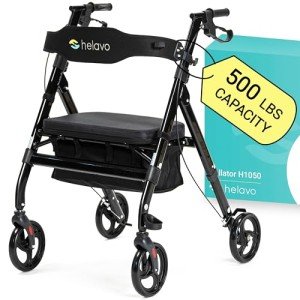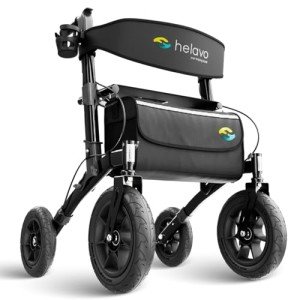
Rollator Walker
Add a review FollowOverview
-
Founded Date 23 Tháng 2, 1994
-
Sectors Automotive Jobs
-
Posted Jobs 0
-
Viewed 3
Company Description
What’s The Current Job Market For Innovative Walker Design Professionals Like?
Innovative Walker Design: A Leap Towards Enhanced Mobility
As the international population ages, the demand for effective mobility solutions has actually ended up being increasingly pushing. Conventional walkers, while practical, are typically slammed for being cumbersome and lacking design development. However, a wave of development has infiltrated the market, coming up with modern walker styles that not just accommodate the physical needs of users but likewise emphasize design, ergonomics, and technology. This article explores these groundbreaking walker styles, their features, and how they are enhancing the self-reliance of people with mobility challenges.

The Evolution of Walker Design
Historical Perspective
Walkers have actually come a long way considering that their beginning in the early 20th century. Initially designed as easy metal frames, these mobility help saw gradual enhancements over the decades. As awareness about ergonomics and user convenience increased, designers started presenting features that much better fit the unique requirements of seniors and individuals with disabilities.
Current Trends
Over the last few years, innovative walker styles have actually utilized technology, ergonomics, and modern looks. Below are a few of the key features that are changing the All-Terrain Walker landscape:
| Feature | Description | Advantage |
|---|---|---|
| Lightweight Materials | Usage of materials like aluminum and composite polymers | Much easier to maneuver and transport |
| Adjustable Height | Adjustable measurements for each user | Improved convenience and suitability |
| Compact Design | Folds for easy storage and portability | Convenience for users on the go |
| Integrated Technology | Features like wise sensors and GPS | Enhanced safety and navigation |
| Trendy Aesthetics | Color options and stylish styles | Increases user self-confidence and desirability |
Innovative Features of Modern Walkers
1. Ergonomic Design
Recent walker models prioritize ergonomics, guaranteeing that the height, deal with grip, and general shape cater to the user’s convenience. For example, curved deals with or hand grips made from soft, slip-resistant materials assist reduce stress on the wrists and hands during use.
2. Smart Technology
A noteworthy trend in walker design is the combination of wise technology. Some modern walkers come equipped with sensors that inform caretakers or relative if the user falls or shows indications of distress. Furthermore, built-in GPS technology enables users to browse unknown surfaces securely.
3. Multi-Functional Capabilities
Innovative walkers now offer additional functionality beyond just helping with mobility. Some styles include integrated seats, storage baskets, and even cup holders. This multi-functional approach enables users to rest when needed and bring essential items, consequently promoting independence.

4. Customizable Features
The capability to customize a walker to fit private requirements has actually become a significant selling point. Adjustable frames, colorful accessories, and other customizable components enable users to have a walker that feels distinctively theirs.
5. Wheel Options
Some walkers now include numerous wheel choices, including bigger wheels for rough surface or smaller ones for flat surfaces. This versatility ensures that users can browse different environments without feeling unsteady or uneasy.
Advantages and disadvantages of Innovative Walkers
While the improvements in walker design bring various advantages, it’s important to consider both the benefits and disadvantages.
| Pros | Cons |
|---|---|
| Increased safety and stability | Possible for higher costs |
| Greater user comfort and use | Some features might be unneeded for all users |
| Stylish design choices enhancing user spirits | Technology can be daunting for some users |
| Boosted portability and storage alternatives | Maintenance of Advanced Walker technology may be required |
Frequently Asked Questions (FAQs)
Q1: Are innovative walkers more expensive than conventional walkers?
A1: Yes, innovative walkers often feature higher cost due to their advanced features and products. However, the financial investment may be beneficial for the included safety, convenience, and self-reliance they provide.
Q2: How do I select the best walker for my requirements?
A2: When selecting a walker, consider your everyday activities, physical capabilities, and any specific requirements you may have (such as storage or technology). Experimenting with different models in-store can help you discover one that feels comfortable.
Q3: Are there walkers developed particularly for seniors?
A3: Many modern walkers cater particularly to the needs of seniors, including lightweight products, ergonomic styles, and Easy Maneuver Rollator Walker-to-use performances that enhance use.
Q4: Can walkers be used outdoors?
A4: Absolutely! Numerous Innovative Walker Design (tucker-lott.thoughtlanes.net) walkers come with larger wheels matched for outdoor surfaces, making it easier for users to browse parks, walkways, and irregular ground.
Q5: Do walkers need much maintenance?
A5: Maintenance needs differ by model. Fundamental cleaning and periodic look at wheels and mechanisms are usually adequate. Technically advanced walkers might need software updates or battery replacements for sensors.
The innovative walker styles currently emerging in the market are a testimony to the creative approaches being required to boost mobility aids. These walkers not just serve their fundamental function however also enrich the user’s quality of life by including safety, performance, and aesthetic appeals into their design. As we continue to embrace these developments, it’s vital for users and caregivers alike to remain notified about their options, ensuring that people maintain their independence and delight in the flexibility of motion.
With technology continuing to progress, the future of walker design appears intense, promising improved solutions for mobility that cater to an ever-growing need for inclusivity and user-centered design.


